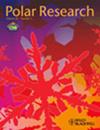Summertime tintinnids in surface water of the Weddell and Cosmonaut seas: community structure and relationships with different water masses
IF 1.3
4区 地球科学
Q3 ECOLOGY
引用次数: 0
Abstract
Tintinnids (Ciliophora) are important microzooplankton grazers. In the Southern Ocean, they are found in the Antarctic Zone, Polar Front and Subantarctic Zone. The Antarctic Zone encompasses large gyres (Weddell Gyre and Ross Gyre) and the Antarctic Slope Current around the continent. The influence of these water masses on tintinnid communities has not been studied. This study investigated the tintinnid community structure in the Weddell and Cosmonaut seas in the summer of 2022. In the Weddell Gyre, tintinnid abundance was significantly lower in the interior than at the fronts. The dominant species differed between the east and west fronts: the proportion of Codonellopsis gaussi was high at the west front, whilst Laackmanniella naviculaefera, Salpingella sp. and Salpingella faurei showed high abundances at the east front. Tintinnid communities varied from inshore to offshore of the Cosmonaut Sea, possibly because of the influence from the Antarctic Slope Current and Antarctic Circumpolar Current. The Antarctic Slope Current was characterized by the occurrence of Cymatocylis drygalskii, whilst the Antarctic Circumpolar Current was characterized by Codonellopsis glacialis, Cymatocylis convallaria and Cy. calyciformis. We proposed that Cy. drygalskii can be used as an indicator of the Antarctic Slope Current. Moreover, we classify polymorphic C. gaussi into three types, in accordance with their loricae, and report their distribution characteristics in water masses. Our results contribute to a better understanding of tintinnid horizontal distribution in different parts of the Weddell Gyre and water masses and serve as a baseline for future studies of pelagic community responses to climate change in the Southern Ocean.威德尔海和科斯莫纳特海夏季表层海水中的褐藻:群落结构及与不同水团的关系
纤毛虫(Tintinnids)是重要的微型浮游动物食肉动物。在南大洋,它们分布在南极区、极地前沿和亚南极区。南极区包括环绕南极大陆的大回旋(威德尔回旋和罗斯回旋)和南极坡流。这些水团对丁丁鱼群落的影响尚未研究。本研究调查了 2022 年夏季威德尔海和科斯莫纳特海的丁丁虫群落结构。在威德尔环流中,内部的丁钩鱼丰度明显低于前沿。东西两侧前沿的优势物种有所不同:Codonellopsis gaussi 在西侧前沿的比例较高,而 Laackmanniella naviculaefera、Salpingella sp.和 Salpingella faurei 在东侧前沿的丰度较高。可能由于受到南极斜坡流和南极环极流的影响,科斯莫诺海从近岸到近海的丁鲷群落各不相同。南极斜坡洋流的特点是出现 Cymatocylis drygalskii,而南极环极洋流的特点是出现 Codonellopsis glacialis、Cymatocylis convallaria 和 Cy.我们建议将 Drygalskii 作为南极斜坡洋流的指标。此外,我们还将多态的C. gaussi按照它们的叶舌分为三种类型,并报告了它们在水团中的分布特征。我们的研究结果有助于更好地理解丁鲷在威德尔回旋不同区域和水团中的水平分布,并为未来研究南大洋浮游群落对气候变化的响应提供基线。
本文章由计算机程序翻译,如有差异,请以英文原文为准。
求助全文
约1分钟内获得全文
求助全文
来源期刊

Polar Research
地学-地球科学综合
CiteScore
3.20
自引率
5.30%
发文量
22
审稿时长
>12 weeks
期刊介绍:
Since 1982, Polar Research has been the international, peer-reviewed journal of the Norwegian Polar Institute, Norway''s central institution for research, environmental monitoring and mapping of the polar regions. Aiming to promote the exchange of scientific knowledge about the Arctic and Antarctic across disciplinary boundaries, Polar Research serves an international community of researchers and managers. As an open-access journal, Polar Research makes its contents freely available to the general public.
Original primary research papers comprise the mainstay of Polar Research. Review articles, brief research notes, letters to the editor and book reviews are also included. Special issues are published from time to time.
The scope of Polar Research encompasses research in all scientific disciplines relevant to the polar regions. These include, but are not limited to, the subfields of biology, ecology, geology, oceanography, glaciology and atmospheric science. Submissions from the social sciences and those focusing on polar management and policy issues are welcome. Contributions about Antarctica are particularly encouraged.
 求助内容:
求助内容: 应助结果提醒方式:
应助结果提醒方式:


